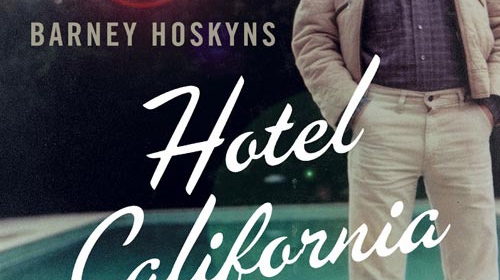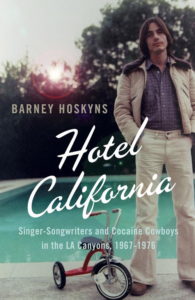Hotel California: Singer-Songwriters and Cocaine Cowboys in the LA Canyons 1969-1976

Hotel California: Singer-Songwriters and Cocaine Cowboys in the LA Canyons, 1967-1976
by Barney Hoskyns
316pp, Fourth Estate, £14.99
The subtitle may sound like a specialist subject on Mastermind. But if you are looking for the ingredients traditionally required of a good rock’n’roll story, then Hotel California has got the lot. Diving deep into the mythology of the Los Angeles singer-songwriter scene of the early 1970s, Barney Hoskyns has surfaced with a murky tale in which a sprawling cast of A-list celebrities nurture their collective inner child with a steady diet of promiscuous sex, hard drugs and soft tunes spiced with appropriately confessional lyrics.
Sign up to our Bookmarks newsletter
Read more
The narrative focuses on the creative activities (in all senses of the phrase) of an incestuous network of self-regarding troubadours (including Joni Mitchell, Jackson Browne, Neil Young, Linda Ronstadt and Gram Parsons), squabbling groups (the Byrds, the Eagles, Crosby, Stills & Nash, the Mamas and the Papas, Fleetwood Mac) and ruthless businessmen (David Geffen, Elliot Roberts), who between them turned California, for a while, into the centre of the pop universe.
The laid-back, West Coast sound of the 70s was widely regarded as one of the golden eras of pop, and it was certainly one of the most commercially successful. Their Greatest Hits by the Eagles remains the best-selling album ever released. Tapestry by Carole King, Rumours by Fleetwood Mac and the self-titled debut album by Crosby, Stills & Nash are all ranked high among the biggest-selling albums of all time. But the rapid accumulation of fame and riches, did not, according to Hoskyns, make any of these pampered elites less miserable or selfish – if anything quite the reverse.
While appreciating the charms of their music, and steering the reader in the direction of some overlooked gems from the period, Hoskyns is more concerned to unravel the patchwork of events behind the songs. This he does with the patient, detached air of a historian, providing a measured overview of events that happened more than 30 years ago.
Hoskyns has visited this scene before with his widely acclaimed book Waiting for the Sun, published in 1996, which traced the development of the modern LA music industry from its origins in the 40s up to the 90s. His focus is considerably narrower in Hotel California, but he still has a vast terrain to cover, and the book is, of necessity, a mosaic of brief encounters in which the great majority of characters are portrayed as little more than thumbnail sketches.
The story is rich in drama, but Hoskyns allows the reader little time to dwell on it. The moment when Linda Ronstadt met her love rival Joni Mitchell on the doorstep of singer-songwriter and notorious womaniser JD Souther’s house, is one of many intriguing personal episodes which are merely recorded in passing. On a more serious note, the murders of Sharon Tate and her friends by the Charles Manson gang are afforded a cursory mention, before the author declares that the story has been recounted so many times before that “we need not dwell on it here”. But Manson and his so-called “family”, who had befriended several local musicians, notably Neil Young and Dennis Wilson of the Beach Boys, were emblematic of a dark force which stalked this seemingly idyllic enclave. To brush off such a mind-blowing incident in a mere page or so seems a little disingenuous.
Advertisement
The book does, nevertheless, capture the deeply confused spirit of the times with an unerring skill. “My style at that time was very intimate,” James Taylor said. “To criticise it, it was very self-centred, very autobiographical, and you could call it narcissistic. But the upside of that was that it was very accessible, and I think people liked that.” Frank Zappa took a more cynical view, referring to the rise of “the horrible fake-sensitive type artist/singer/ songwriter/suffering person, posed against a wooden fence provided by the Warner Bros Records art department, graciously rented to all the other record companies who needed it for their version of the same crap.”
Hoskyns’s story tends to support the Zappa worldview, and anyone who fondly imagines that the lofty declarations of peace, love and harmony routinely expressed in their songs bore any relation to the backstage behaviour of groups such as the Eagles and Crosby, Stills, Nash & Young will find their illusions comprehensively dismantled by Hotel California. “The dressing room wasn’t big enough to contain these egos,” Hoskyns dryly notes, as he details a succession of spectacularly ugly rows between Neil Young and Stephen Stills which left their bandmate Graham Nash in tears.
The overriding problem, on which all others hinged, was the endemic use of drugs, particularly cocaine, as a social oil which eventually turned to glue. “Cocaine made people deaf, it made people dead and it made people real obnoxious,” observed Ronstadt.
The problem was not confined to the stars. “By the end of 1975 there’d be a weekly marketing meeting in a big conference room,” recalled an executive at A&M Records, “And people would get up and leave the room all the way through the meeting. Everybody was doing it.”
By the end of the book the Eagles and Ronstadt are off playing to vast crowds in coliseums, while the Troubadour club, where they all started out, was on the verge of closure and, as one insider put it, even the bartenders were “all fucked up on pills and coke”. Tellingly, only Jackson Browne returned to play a benefit to help the club out of its financial difficulties.
It is a complicated and detailed story requiring Hoskyns to keep a lot of narrative plates spinning throughout, a feat which he manages to pull off, by and large, with a minimum of breakages. The smooth passage of the book does, however, suffer from the author’s confusing habit of identifying the participants by a constantly changing combination of their first and second names, a curious stylistic tic which needlessly increases the effort required to keep track of the characters involved.
Hotel California is nevertheless an ambitious and authoritative account which makes overdue sense of a spectacularly decadent period of pop history, a time when rock stars and music industry businessmen alike had it all on a plate – or, more likely, a silver tray. David Sinclair’s Wannabe: How The Spice Girls Reinvented Pop Fame is published by Omnibus.

